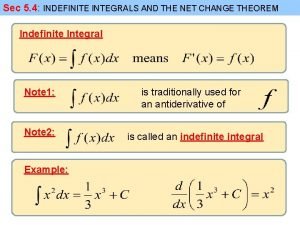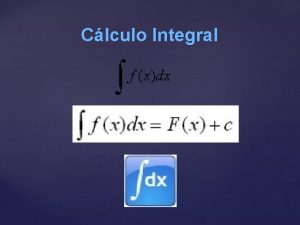Surface Integral Surface integral of the first type






![On each Si C let us select an arbitrary point [xi, yi, zi] and On each Si C let us select an arbitrary point [xi, yi, zi] and](https://slidetodoc.com/presentation_image_h/94e1b9c4fcb7635df6f943714e971c84/image-7.jpg)










![On each Si Q let us select an arbitrary point [xi, yi, zi] and On each Si Q let us select an arbitrary point [xi, yi, zi] and](https://slidetodoc.com/presentation_image_h/94e1b9c4fcb7635df6f943714e971c84/image-18.jpg)


![We see that, for v [0, /2], z [0, h] we have w. n We see that, for v [0, /2], z [0, h] we have w. n](https://slidetodoc.com/presentation_image_h/94e1b9c4fcb7635df6f943714e971c84/image-21.jpg)
- Slides: 21

Surface Integral • Surface integral of the first type in a scalar 3 D-field • Surface integral of the second type in a vector field

Surface integral in a scalar field - motivation Calculate the total amount of rainfall on a hill which has approximately the form of a cone if the precipitation rate is linearly proportionate to the height above the sea level.

Mathematical model: The hill is ideally a cone and, with a height h and radius r, it may have the following parametric equations: where M is a circle with a radius of r and the centre at the origin. v z M h r r x y u

The precipitation rate in mm could be expressed as where c is an appropriate constant. To calculate the total amount of rainfall R fallen on the hill, we have to “add up” the precipitation rate over the whole hill surface area H. We will call this quantity the surface integral of with respect to H and denote by d. S is sometimes called the element of surface

Exact definition Let us further assume that a continuous function f(x, y, z) is defined on a a simple surface : where M is a contiguous planar area contained within a regular curve M z v M [x, y, z] y M u x

To define exactly the surface integral of f(x, y, z) with respect to , let us first introduce a partition P with a norm N(P) (the area of the largest rectangle. P v C z Si S M Mi y u x This generates a curvilinear partition C of
![On each Si C let us select an arbitrary point xi yi zi and On each Si C let us select an arbitrary point [xi, yi, zi] and](https://slidetodoc.com/presentation_image_h/94e1b9c4fcb7635df6f943714e971c84/image-7.jpg)
On each Si C let us select an arbitrary point [xi, yi, zi] and calculate| Si | f(xi, yi, zi) where | Si | is the area of Si. We can now define the integral sum exists, we define the surface integral of f(x, y, z) with respect to S as:

To calculate a surface integral, we replace each Si by the parallelepiped defined by the tangent vectors tu, tv at the bottom left corner of Si C z tu Si tv y We have x where

Then we can write So the formula for calculating a surface integral is:

Example Let us calculate the motivating example. We will obtain the following surface integral: where H: The tangent vectors are: and so we have:

This yields and we get the following double integral: After some simplification, we can write

Calculating, we obtain where in the second integral we used the transformation Completing the calculation, we have

Surface integral in a vector field - motivation What is the force of wind blowing at an angle of 45 o with force constantly increasing as we rise from the sea level driving a draft with a sail that has the form of one eighth of a cylindrical surface?

Mathematical model The sail is ideally an eighth of a cylindrical surface with a height h and radius r situated, say, in the first octant as shown in the figure below. Then it has the equations h r The vector field of the wind can be modeled as

In physics we are taught that the force with which the vector field w=czi+0 j+0 k affects a surface S at a point [x, y, z] is calculated as the scalar product of w with the normal n at [x, y, z]. Thus if, for example, the wind blew parallel to the tangent plane at [x, y, z], the resulting force would be zero. All we have to do to calculate the total force of the wind acting upon the sail is "add up" the products w n over all the sail surface. This operation in the case of continuous functions is called the surface integral of the second type of the vector field over the surface S and in our caser we would use the following notation:

Exact definition Let us further assume that a continuous vector field f(x, y, z)=f 1(x, y, z)i + f 2(x, y, z)j + f 3(x, y, z)k is defined on a a simple surface : where M is a contiguous planar area contained within a regular curve M n t z u v M [x, y, z] tv y M u x

Let us again introduce a partition P with a norm N(P) with the resulting curvilinear partition C of . P v C z Si S M Mi y u x
![On each Si Q let us select an arbitrary point xi yi zi and On each Si Q let us select an arbitrary point [xi, yi, zi] and](https://slidetodoc.com/presentation_image_h/94e1b9c4fcb7635df6f943714e971c84/image-18.jpg)
On each Si Q let us select an arbitrary point [xi, yi, zi] and calculate n f at this point. We can now define the integral sum exists, we define its value as the surface integral of f(x, y, z) with respect to S. Formally:

Sometimes the following vector notation is used: The formula for calculating a second-type surface integral of the vector field f(x, y, z) can be derived in a way similar to that for the surface integral of the first type where is either 1 or -1 if depending on whether is oriented in correspondence with the parametric equations or not.

Example We will again calculate the motivating example. Here the equations of the surface, that is, the sail S are and the vector field of the blowing wind is given Let us first calculate n
![We see that for v 0 2 z 0 h we have w n We see that, for v [0, /2], z [0, h] we have w. n](https://slidetodoc.com/presentation_image_h/94e1b9c4fcb7635df6f943714e971c84/image-21.jpg)
We see that, for v [0, /2], z [0, h] we have w. n =c z r cos u 0 and so, for practical reasons, we will orientate the sail in correspondence with the parametric equations since we want the force of the wind to be positive. Then we can write:
 Difference of definite and indefinite integral
Difference of definite and indefinite integral Integral citation
Integral citation Non integral citation
Non integral citation Contoh soal integral permukaan
Contoh soal integral permukaan Exchange difference of integral foreign operation is
Exchange difference of integral foreign operation is Integral tak tentu
Integral tak tentu Hình ảnh bộ gõ cơ thể búng tay
Hình ảnh bộ gõ cơ thể búng tay Frameset trong html5
Frameset trong html5 Bổ thể
Bổ thể Tỉ lệ cơ thể trẻ em
Tỉ lệ cơ thể trẻ em Chó sói
Chó sói Thang điểm glasgow
Thang điểm glasgow Chúa sống lại
Chúa sống lại Các môn thể thao bắt đầu bằng tiếng bóng
Các môn thể thao bắt đầu bằng tiếng bóng Thế nào là hệ số cao nhất
Thế nào là hệ số cao nhất Các châu lục và đại dương trên thế giới
Các châu lục và đại dương trên thế giới Công của trọng lực
Công của trọng lực Trời xanh đây là của chúng ta thể thơ
Trời xanh đây là của chúng ta thể thơ Mật thư anh em như thể tay chân
Mật thư anh em như thể tay chân Phép trừ bù
Phép trừ bù độ dài liên kết
độ dài liên kết Các châu lục và đại dương trên thế giới
Các châu lục và đại dương trên thế giới









































